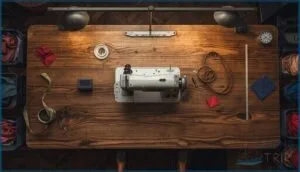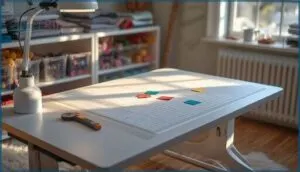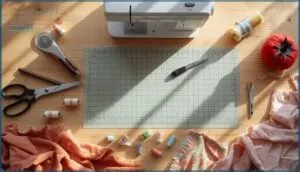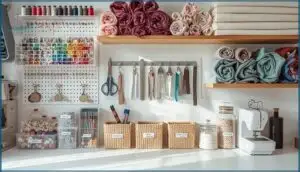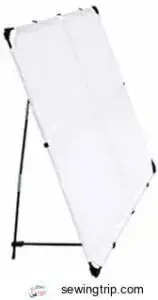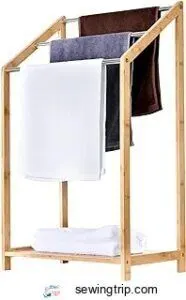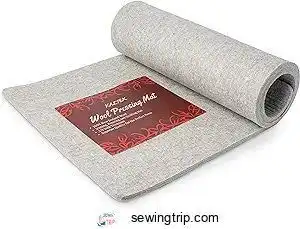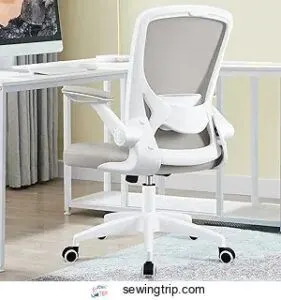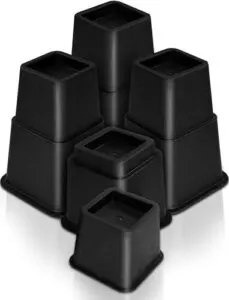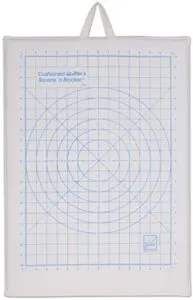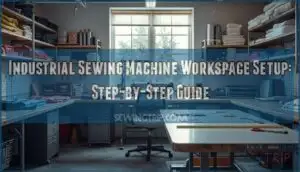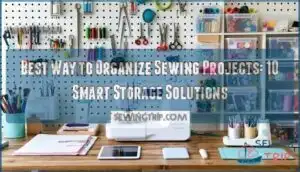This site is supported by our readers. We may earn a commission, at no cost to you, if you purchase through links.

Your sewing machine sits on the dining table, fabric spills from a closet shelf, and you’re measuring hems on your knees again. This scattered approach works until a project deadline hits, and you’re wasting precious creative time hunting for matching thread or clearing space to cut.
Setting up a sewing station transforms these frustrations into an efficient workflow, where every tool lives within arm’s reach and your workspace adjusts to the project at hand. The difference isn’t just about tidiness—it’s about claiming dedicated space that respects your craft and protects your body from the strain of makeshift setups.
With smart furniture choices, strategic storage, and proper lighting placement, you can build a sewing station that fits your available square footage and elevates every stitch you make.
Table Of Contents
- Key Takeaways
- Choosing The Ideal Space for Sewing
- Essential Furniture and Workspace Setup
- Must-Have Tools and Equipment
- Organization and Storage Solutions
- Top 10 Products for Your Sewing Station
- 1. Large White Quilt Design Wall System
- 2. Bamboo Towel Rack Organizer Stand
- 3. Large Wool Quilting Pressing Mat
- 4. Modern Oak Computer Office Desk
- 5. Electric Standing Desk Converter
- 6. Ergonomic Mesh Office Chair
- 7. Comfortable High Back Office Chair
- 8. Adjustable Heavy Duty Bed Risers
- 9. Heavy Duty S Shaped Hooks
- 10. Portable Quilter Pressing Mat Natural
- Frequently Asked Questions (FAQs)
- Conclusion
Key Takeaways
- A dedicated sewing station eliminates time-wasting searches for tools and supplies by positioning everything within arm’s reach, transforming scattered setups into efficient workflows that protect your body from strain.
- Strategic furniture placement—including a sturdy 40-80 inch wide table at 28.5-30.5 inches high, ergonomic seating, and a cutting surface positioned 32-38 inches from the floor—creates a natural work triangle between cutting, stitching, and pressing zones.
- Smart storage systems using clear bins, vertical fabric racks, and wall-mounted shelving cut retrieval time by 30-60% while maximizing square footage through vertical organization rather than floor space consumption.
- Proper lighting design combines natural window placement with layered LED task lamps (1000-1500 lumens, 5000-6500K) to reduce eye strain by 30% and boost productivity by up to 20% during precision work.
Choosing The Ideal Space for Sewing
Your sewing station starts with the right room, and that choice sets the tone for everything else. You’ll need to think about how much space you have to work with, where your outlets are, and how light moves through the area.
Let’s walk through the key factors that’ll help you nail down the perfect spot for your setup.
Assessing Room Size and Layout
Your sewing room dimensions set the foundation for everything else. Even compact spaces work beautifully when you measure carefully and plan ergonomic zones for cutting, pressing, and stitching.
Layout planning transforms any area into a functional sewing workspace optimization hub. Prioritize room dimensions that allow comfortable movement, guarantee ventilation needs are met, and position your sewing station setup where natural light flows freely for better visibility and reduced eye strain.
A well-designed space incorporates sewing room layouts to boost efficiency and productivity.
Utilizing Offices, Bedrooms, or Shared Spaces
Offices claim 62% of home sewing stations because existing furniture and outlets support instant room conversion. Bedrooms offer quieter privacy for 47% of hobbyists, while 54% of urban sewists master shared area multi-use setups with portable stations.
Your space optimization strategy hinges on home integration that balances natural light, workflow access, and storage solutions. Adjustable furniture and vertical shelving deliver sewing workspace optimization without sacrificing your room’s original purpose.
Effective sewing space organization requires considering the sewing supply zones to boost productivity.
Importance of Electrical Outlets and Ventilation
You’ll need dedicated circuits to power your sewing station without tripped breakers, placing outlets every 12 feet along workspace walls for electrical safety and sewing efficiency. Proper outlet placement and power management transform sewing workspace functionality and storage solutions accessibility.
Ventilation systems with 0.06 CFM per square foot clear airborne fibers and adhesive fumes, protecting air quality in your sewing room while reducing dust on machines.
Maximizing Natural and Task Lighting
Beyond electrical access, lighting design shapes your entire workspace experience. Position your sewing station near windows to capture natural light, reducing eye strain by 30% and boosting productivity up to 20%. Layer ambient lighting with focused task illumination for precision work.
- Install LED task lamps providing 1000-1500 lumens at your machine
- Choose daylight bulbs (5000-6500K) for accurate color matching
- Add adjustable desk lamps to eliminate hand shadows
- Use light walls to increase brightness reflection by 25%
Essential Furniture and Workspace Setup
Your furniture choices can make or break your sewing experience, directly affecting how long you can work comfortably and how efficiently you move through projects. The right desk height, chair support, and table placement create a workspace that flows naturally from cutting to stitching to pressing.
Let’s look at the core furniture pieces you’ll need to build a functional sewing station that works with your body, not against it.
Selecting a Sturdy Sewing Table or Desk
Your sewing station setup hinges on a rock-solid foundation. Look for tables with steel frames or solid wood construction, as these materials minimize vibration during high-speed stitching. Standard heights around 28.5 to 30.5 inches promote proper sewing ergonomics, while surfaces between 40 to 80 inches wide give you room to spread fabric without cramping your workspace.
Heavy-duty models support machines weighing 100+ pounds, ensuring long-term workspace optimization and stability.
Ergonomic Chair Options for Comfort
Posture correction starts with the right sewing chair—one that molds to your body rather than fighting it. An ergonomic setup transforms marathon stitching sessions from painful to productive.
- Adjustable height ranging 18-22 inches aligns you perfectly with any sewing table
- Dual lumbar support systems cradle your lower spine’s natural curve
- Breathable mesh materials prevent overheating during extended work sessions
- Multi-directional armrests reduce shoulder tension while guiding fabric
- 360-degree swivel bases with lockable casters balance mobility and stability
Ergonomic design in chair materials directly impacts your sewing studio comfort and long-term health.
Setting Up a Functional Cutting Table
Your cutting table dimensions shape every fabric cut you make—aim for surfaces around 58 inches wide by 36 inches deep to accommodate most projects. Set the ergonomic height between your hip and elbow when standing, usually 32-38 inches, preventing strain during extended sessions.
Integrate storage solutions like shelves beneath your cutting surfaces, and position task lighting 14 inches overhead for precision with cutting tools in your sewing station setup.
Positioning The Ironing Board for Efficiency
Place your ironing board within 3-6 feet of your machine to cut shift time by up to 25%—this Pressing Station layout forms a natural work triangle between cutting, stitching, and pressing.
Set the board just below elbow height to protect your shoulders during extended use, and allow 24-36 inches of clearance on two sides for safe movement.
Smart Ironing Board Placement transforms your sewing efficiency tips into measurable Workflow Optimization and Efficiency Gains throughout your sewing station.
Must-Have Tools and Equipment
Your sewing station needs the right tools to transform good intentions into finished projects. Without sharp cutters, accurate measuring tools, and a machine you can rely on, even the best-designed workspace won’t deliver the results you’re after.
Here’s what belongs in every functional sewing setup.
Choosing a Reliable Sewing Machine
Your sewing station setup hinges on selecting a machine built to last. Look for brands like Brother, Janome, or SINGER—they consistently earn top ratings and dominate market share.
Prioritize metal frames over plastic bodies for extended durability, check user reviews for real-world performance, and confirm warranty support covers mechanical failures.
Factor in sewing machine maintenance costs and replacement part availability to protect your investment long-term.
Selecting Quality Cutting Tools
Sharp blades transform fabric into finished projects faster than you think. Over 80% of professional-grade scissors use high carbon stainless steel for lasting edge retention, while tungsten carbide rotary cutters outlast standard blades by five times.
Sharp blades are essential—professional scissors use high-carbon steel, and carbide rotary cutters last five times longer
Investing in quality cutting tool materials now saves you from frequent replacements later.
Prioritize these cutting tools for your sewing station setup:
- Fabric scissors with hardened steel for precision cutting techniques
- Rotary cutters featuring ergonomic grips and blade sharpness indicators
- Safety locks reducing accidental exposure by 33%
- Thread snips for quick trimming
- Replacement blades maintaining workflow efficiency
Key Measuring and Marking Tools
Once your cutting tools are ready, measuring tapes and marking tools give you control over every stitch. A flexible 60-inch measuring tape manages body measurements and curved surfaces, while seam gauges mark hems with precision. Water-soluble fabric markers leave no permanent trace, and quilter’s rulers guarantee accuracy for sewing supplies. These sewing essentials transform your sewing station setup into a hub for precision cutting.
Threads, Notions, and Stabilizers Essentials
With precision in hand, thread types and stabilizer materials round out your sewing essentials. Stock polyester and cotton threads in core colors, as the apparel industry consumes over $1.7 billion annually in sewing thread alone.
Keep these sewing supplies ready:
- Cut-away stabilizers for stretch fabric interfacing
- Tear-away options for woven materials
- Water-soluble stabilizers for delicate work
- Essential notion usage items like bobbins and needles
Organization and Storage Solutions
A well-organized sewing station transforms chaos into creative flow, keeping everything you need within arm’s reach. Smart storage isn’t just about tidying up—it’s about designing a system that works with your process, not against it.
Here’s how to organize fabrics, tools, patterns, and supplies so your space stays functional and inspiring.
Fabric Storage Ideas and Organizers
Your fabric deserves more than a chaotic pile. Clear storage bins let you spot materials instantly, cutting search time by up to 60%, while vertical fabric racks optimize wall space and display up to 120 yards per 10 feet.
Foldable fabric cubes offer flexible sewing storage that collapses when not needed, and open shelf organizers keep your entire stash visible, organized, and ready for your next project.
Tool and Accessory Storage Systems
Once your fabrics are sorted, your tools need equal attention. Modular storage with adjustable dividers cuts retrieval time by 40%, while pegboard systems improve workspace efficiency by 25%. Rolling carts with lockable wheels add mobility without spills, and color-coded labeling reduces search time by 21%.
These sewing storage solutions transform chaos into command, keeping scissors, presser feet, and notions accessible when inspiration strikes.
Pattern and Instruction Organization
Your pattern library deserves its own command center—start by sorting instruction management into binders with sheet protectors, used by 54% of organized crafters. Digital pattern storage solutions let you access sewing templates instantly, while 62% sort by garment type for faster retrieval. Hybrid organization systems combine physical folders with digital tracking, giving you complete control over your sewing essentials guide.
Labeling, Bins, and Wall-Mounted Shelving
Label management transforms your sewing station. Clear bins cut search time by 30%, while wall-mounted shelving maximizes space efficiency without sacrificing floor area.
You’ll boost workspace efficiency by 40% when you combine labeled storage solutions with smart shelf optimization.
Color-coded systems improve retrieval accuracy by 17%, and separate bins for notions guarantee your sewing supplies management stays uncluttered. That’s bin organization that delivers real results.
Top 10 Products for Your Sewing Station
The right products can transform a cluttered corner into a well-organized workspace where every tool has its place and every movement feels natural. From design walls that let you visualize your projects to ergonomic seating that sustains hours of focused work, these essentials address both function and comfort.
Here are ten standout products that’ll help you build a sewing station worth showing off.
1. Large White Quilt Design Wall System
When you’re arranging quilt blocks on a vertical surface, you’ll transform your workflow from guesswork to precision. This portable design wall system features a 72-inch cotton flannel surface that holds fabric pieces without pins, letting you see your entire quilt layout at once.
You can assemble it in minutes and disassemble it just as quickly for storage or travel. The textured flannel provides excellent grip for block placement, though you’ll want to position it on a stable surface since the frame can tip when adjusting larger pieces or smoothing fabric.
Best For: Quilters who need a portable workspace to visualize full quilt layouts and make color decisions without pinning blocks to the floor or bed.
- The 72-inch cotton flannel surface holds fabric pieces securely without pins, making it easy to rearrange blocks and experiment with different layouts.
- Quick assembly and disassembly means you can set it up when you’re working and pack it away in the included bag when you need the space back.
- The compact, portable design works well for taking to quilting retreats or classes while keeping your block arrangements intact.
- The frame can feel flimsy and may tip over when you’re smoothing fabric or moving larger quilt sections around.
- Some users report stability issues, with the structure bending or requiring careful handling to prevent it from collapsing during use.
- At 72 inches, it won’t accommodate king-size quilts or larger projects that typically need 120 inches or more of design wall space.
2. Bamboo Towel Rack Organizer Stand
You’ll love how a three-tiered bamboo towel rack transforms into a clever sewing organization powerhouse. This eco-friendly, compact design fits tight corners while delivering serious storage solutions for your sewing station setup.
At 41 inches tall, it holds fabric rolls on the bars, thread collections on the bottom shelf, and lightweight notions throughout. The space-saving footprint works brilliantly in shared sewing room organization setups, and you can relocate it instantly as projects evolve.
For around $50, this bamboo storage unit combines sustainability with smart sewing supplies management.
Best For: Sewers working in small spaces who need flexible, eco-friendly storage for fabric rolls, thread collections, and lightweight notions without permanent installation.
- Three-tier design with bottom shelf maximizes vertical storage while maintaining a compact 15.9″ x 11.1″ footprint that fits tight corners and shared workspaces.
- Lightweight bamboo construction (4-10.5 lbs) allows easy repositioning as your sewing projects evolve, plus natural antimicrobial properties protect stored fabrics from moisture damage.
- Budget-friendly at around $50 with sustainable bamboo material that creates a calming, organized workspace aesthetic while reducing environmental impact.
- Narrow 15.9-inch width may not accommodate wider fabric bolts or larger storage baskets, limiting versatility for bulkier sewing supplies.
- Tier spacing and height (41 inches total) might not suit very tall users or those needing to hang longer fabric pieces or garments-in-progress.
- Glossy finish and lack of screw covers create a less polished appearance that may clash with some sewing room decor preferences.
3. Large Wool Quilting Pressing Mat
A 22″ x 60″ wool mat brings pressing techniques to a whole new level at your sewing station. Made from 100% New Zealand wool, this half-inch thick surface retains heat and reflects it back, cutting your pressing time by up to 50% through dual-sided efficiency.
The textured finish grips fabric securely, preventing shifting while you press seams flat. You’ll achieve quilting efficiency and fabric stability without scorching, and the mat accommodates pins beautifully.
For mat maintenance, spot clean with pH-neutral products and air-dry completely between storage solutions cycles.
Best For: Quilters and sewers working on large projects who need faster, more precise pressing with heat retention that cuts ironing time in half.
- The 100% New Zealand wool construction retains and reflects heat so you can press both sides of fabric at once, reducing pressing time by up to 50% compared to regular ironing boards.
- The textured surface grips fabric securely to prevent shifting and stretching during pressing, giving you crisper seams and fewer errors on pieced blocks.
- At 22″ x 60″, this extra-large mat handles big quilt blocks and projects easily, and the half-inch thickness provides consistent heat distribution across the entire surface.
- No storage bag or carrying case comes with the mat, so you’ll need to find your own solution for keeping it protected when not in use.
- The mat may have a noticeable wool smell initially, though this typically fades with regular use and proper airing.
- At this size, the mat won’t fit on standard ironing boards and requires a dedicated workspace or large flat surface for use.
4. Modern Oak Computer Office Desk
This 55″ modern oak desk transforms your sewing station into a workspace efficiency powerhouse. The engineered wood with powder-coated steel frame holds monitors, machines, and fabric bundles with ease, while two cable grommets keep cords organized.
At 28″ height, you’ll enjoy proper computer ergonomics during long cutting sessions. The oak finish adds warmth to your sewing room organization scheme, and desk assembly takes minutes with adjustable glides that balance uneven floors.
Pair it with storage solutions like wall shelving to optimize your setup.
Best For: Crafters and sewers who need a spacious, organized workspace that handles heavy machines and long cutting sessions without breaking the bank.
- The 55″ wide surface gives you plenty of room to spread out fabric, patterns, and your sewing machine while the two cable grommets keep power cords tangle-free.
- Adjustable glides mean you can set this up on any floor without wobbling, and the powder-coated steel frame holds up to 100 lbs of equipment.
- Quick assembly and a modern oak finish that looks great in any sewing room, plus it’s light enough to move around when you need to rearrange.
- Some users have run into assembly headaches with misaligned screw holes or wonky welds that make setup frustrating.
- The engineered wood top can scratch or stain pretty easily, so you’ll want to use a cutting mat or be careful with sharp tools.
- A few people found the desk feels wobbly or less sturdy than expected, especially if you’re working with heavier industrial machines.
5. Electric Standing Desk Converter
Your sewing station setup deserves height adjustment flexibility, and this electric standing desk converter delivers motorized lift precision. The converter transitions from 28.6” to 46” at 1.5cm per second, letting you alternate between sitting and standing without workflow interruptions.
Its 125-pound capacity accommodates sewing machines and fabric storage solutions with confidence, while the whisper-quiet motor (under 50dB) maintains focus during detailed work. The maple desktop and powder-coated steel construction guarantee converter safety through thousands of adjustments.
Studies show standing desk users report 31% less musculoskeletal discomfort, making ergonomic design essential for serious sewists pursuing desk customization that backs their craft.
Best For: Sewists who want motorized height flexibility to reduce back strain during long sessions and need a sturdy surface that handles heavy machines without permanent furniture modifications.
- Motorized adjustments move smoothly and quietly (under 50dB), so you can switch positions without disrupting your concentration or creative flow.
- The 125-pound weight capacity and industrial-grade steel frame provide reliable support for sewing machines, cutting mats, and fabric storage.
- Ergonomic design backed by research showing 31% reduction in musculoskeletal discomfort, helping you work longer without neck or back pain.
- The motor needs a 15-minute cooldown after 2 minutes of continuous use, which could be annoying if you adjust height frequently.
- Some users report cosmetic issues like scratches or nicks on delivery, so inspect carefully when it arrives.
- The maximum height of 46″ might not work well for taller sewists who need more adjustment range.
6. Ergonomic Mesh Office Chair
Your back deserves better than hunching over fabric for hours. The KERDOM mesh office chair brings ergonomic design directly to your sewing station, with breathable mesh materials that prevent overheating during long projects.
Chair adjustments include pneumatic height control and flip-up arms, while built-in lumbar support targets the pressure zones sewists know too well.
The 360-degree swivel and solid casters let you pivot between your machine and cutting table without strain. At 250 pounds capacity, this ergonomic setup delivers back comfort that matches your ambition.
Best For: Sewists and crafters who spend long hours at their sewing stations and need breathable, adjustable support to prevent back pain and maintain comfort during extended projects.
- Breathable mesh back keeps you cool during long sewing sessions, preventing the sweaty discomfort that comes with fabric chairs.
- Adjustable height and flip-up arms let you customize the fit for your sewing table and easily slide under when you need more workspace.
- 360-degree swivel and smooth casters make it easy to move between your machine, cutting table, and ironing board without getting up.
- The mesh material can be rough and may snag delicate fabrics or clothing if you’re not careful.
- The chair tends to creak and squeak with movement, which might be distracting during quiet sewing time.
- The seat cushion compresses over time, so the initial comfort level doesn’t always last with heavy daily use.
7. Comfortable High Back Office Chair
Comfort shifts dramatically when you add a high back that wraps your entire spine. The LEMBERI chair pairs a wide padded seat with high-back support that alleviates the neck pain affecting 49% of sewing operators.
Chair height adjusts to match your table, while the armless design gives you the freedom to pull close without obstacles. Cross-legged base stability meets a 350-pound capacity, and that tilt function? It’s the lumbar adjustment your marathon hemming sessions have been missing.
Best For: Sewers and crafters who need freedom of movement and full spine support during long sessions at the machine.
- High back design supports your entire spine and reduces neck strain during extended sewing projects
- Armless frame lets you get right up to your workspace without bumping into obstacles
- Adjustable height and tilt function give you the ergonomic positioning your body needs for comfort
- No wheels means you’ll need to stand up and reposition the chair manually when moving around your workspace
- Seams and stitching may wear faster with heavy daily use based on user reports
- PU leather upholstery requires more care and maintenance compared to fabric options
8. Adjustable Heavy Duty Bed Risers
Raise your cutting table by 3, 5, or 8 inches with Utopia Bedding’s stacking risers—your sewing station setup just claimed serious ergonomic benefits. These heavy-duty materials handle 1,300 pounds combined, transforming any standard desk into an adjustable-height surface that spares your back during fabric prep.
Space optimization happens underneath, where newfound clearance swallows storage bins filled with patterns and notions. Just measure your table legs first—proper fit isn’t optional when bed riser safety determines whether your entire sewing space stays stable or tips mid-project. Sewing room organization starts from the ground up.
Best For: Anyone looking to raise their sewing table, cutting station, or craft desk to a more comfortable working height while creating extra storage space underneath.
- Three height options (3, 5, or 8 inches) let you customize the elevation to match your exact needs, whether you’re standing to cut fabric or sitting to sew.
- Supports up to 1,300 pounds total, so you can confidently raise heavy cutting tables or desks without worrying about stability.
- Creates valuable under-table storage space for bins, fabric stashes, and sewing supplies that would otherwise clutter your workspace.
- The risers are pretty bulky and not particularly attractive, which might bother you if aesthetics matter in your sewing room.
- You need to measure your table legs carefully before buying—if the fit isn’t right, the whole setup becomes unstable and potentially unsafe.
- Won’t work with furniture that has unusually thin or delicate legs, limiting compatibility with some vintage or lightweight tables.
9. Heavy Duty S Shaped Hooks
Organization meets function when you hang those scissors, rulers, and thread spools exactly where you need them—30 polished steel S-hooks transform pegboards and tension rods into a complete hanging system.
These hooks support up to 20-25 pounds each, turning vertical space into accessible sewing storage solutions without sacrificing an inch of your tabletop.
Their smooth finish protects tools from scratches while keeping your sewing supplies visible and grab-ready. Weight capacity matters here—proper hook materials guarantee your sewing room organization holds strong through every project sprint.
Best For: Sewers, crafters, and organizers who need a budget-friendly way to hang tools, supplies, and accessories on pegboards, racks, or tension rods without taking up workspace.
- Heavy-duty steel construction supports up to 20-25 lbs per hook, strong enough for scissors, fabric rolls, and heavier sewing tools.
- Pack of 30 hooks gives you plenty of options to customize your entire sewing room setup without buying multiple sets.
- Smooth polished finish protects delicate tools and fabrics from scratches while keeping everything visible and within reach.
- Requires an existing hanging system like a pegboard, pot rack, or rail—won’t work as standalone storage.
- Open S-shape design means items can slide off if bumped, so they’re not ideal for high-traffic areas.
- 30-pack might be overkill for smaller sewing spaces or minimalist setups where you only need a handful of hooks.
10. Portable Quilter Pressing Mat Natural
This 14” x 20” natural wool pressing mat cuts your ironing time in half—heat reflects through both fabric sides, delivering crisp seams in 3-5 seconds flat. Its half-inch thickness protects surfaces from steam damage, while the built-in handle makes portability easy for classes and workshops.
The felted wool composition resists stretching and maintains accuracy across quilt blocks, though you’ll want to air it out initially. Hand-wash when needed, label it among your sewing supplies, and watch this compact solution transform your sewing station’s efficiency.
Best For: Quilters who need a compact, portable pressing surface that speeds up seam work and travels easily to classes or workshops.
- Cuts pressing time in half with heat-reflective wool that presses from both sides, creating crisp seams in just 3-5 seconds.
- Portable design with a carrying handle and lightweight build (under 2 pounds) makes it easy to take to sewing events or store when not in use.
- Durable felted wool construction resists stretching and protects work surfaces from heat damage while maintaining accuracy across quilt blocks.
- Initial wool odor requires airing out before use, though most users report it fades after a few sessions.
- The built-in handle can sometimes get in the way during ironing, making certain angles or positions awkward.
- International buyers may face additional import taxes, and some users wish it included features like a rotary mat on the reverse side.
Frequently Asked Questions (FAQs)
How often should I clean my sewing machine?
Clean your sewing machine every 10–15 sewing hours or after each major project to maintain peak performance. Follow the manufacturer maintenance tips that recommend professional servicing annually, regardless of your regular cleaning schedules.
Whats the best flooring for a sewing space?
Think of your floor as a stage—vinyl flooring and laminate options offer durable, eco-friendly surfaces for your sewing studio.
Hardwood alternatives simplify pin recovery while supporting ergonomic movement in any crafting space.
How do I reduce sewing machine noise levels?
Reduce sewing machine noise with anti-vibration mats under your machine, acoustic foam enclosures, and regular maintenance. Position your sewing station on carpeted floors, use sound-absorbing curtains, and guarantee proper lubrication for quieter operation.
Can I sew safely with pets or children nearby?
An ounce of prevention is worth a pound of cure—you can sew safely with pets or children nearby by implementing sewing area barriers, household hazard control, and accident risk assessment, plus applying pet safety tips and child injury prevention strategies.
Conclusion
Think of your sewing space like a well-rehearsed performance—every prop positioned, every light cued, every movement choreographed for flow. Setting up a sewing station with intentional furniture placement, accessible storage, and proper lighting transforms scattered creative energy into focused productivity.
You’re not just arranging tables and bins; you’re designing an environment that honors your craft and eliminates the friction between inspiration and execution. Your workspace becomes the foundation where ideas materialize into finished pieces.
- https://www.clinicalcasereportsint.com/open-access/ergonomic-evaluation-of-workstation-for-sewing-machine-operators-in-ethiopia-9501.pdf
- https://pubmed.ncbi.nlm.nih.gov/39188087/
- https://www.dguv.de/ifa;/forschung/projektverzeichnis/bia_4085-2.jsp
- https://www.databridgemarketresearch.com/reports/global-sewing-machines-market
- https://www.thelittlemushroomcap.com/revamping-sewing-space-the-ultimate-guide-to-organizing-your-sewing-room/

